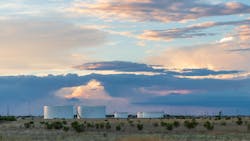Permian Basin Operators Ramp Up Water Recycling, Reuse Efforts
Major operators pouring capital into Permian Basin oil and natural gas fields are also pouring funds into water management.
"The Permian Basin wasn't the Permian Basin five or six years ago," said Brian Sellers, Permian Water Infrastructure manager with ExxonMobil. "There's been a significant buildout of infrastructure, and it's no different with water: Saltwater disposal wells, supply lines, disposal lines."
Participating in a panel discussion at the Produced Water Society's 10th Permian Basin Conference, Sellers said produced water will be the source of over 90% of his company's water used in hydraulic fracturing and production operations.
"The buzz word is beneficial reuse and land discharge, and in five years I hope to say our team is well on the way to executing reuse and land discharge," he said.
The challenge is, first, to prove companies are protecting people and the environment when they recycle produced water, and, second, to keep the water flowing in order to keep water flowing, said Brittany Cheben, Permian Water Strategy manager with Chevron. The third challenge is developing creative solutions in water technology, she said.
Vrajesh Mehta, Water Strategy and Technology Team manager with Occidental Petroleum, joined his fellow panelists in saying his company's goal is to increase recycling of produced water, increase the use of brackish water and reduce the use of fresh water.
"We all have a part to play in ensuring water recycling and continued oil production for this area and for the nation," he said.
Luis Baez, Permian Water Project Integration manager at ConocoPhillips, commented: "For us who care for the Permian Basin, to be able to continue to operate responsibly, we have to work together, bring in the regulators to show what we're doing, recycle water and adopt new technologies. All these solutions we talk about, we need to chip away at the challenges."
The challenges, such as sufficient pore space to store water, make Chevron think very creatively about the value of options and lean into creativity on multiple fronts, said Cheben. Being transparent with regulators, looking at the scale and cost of different technologies, and working with others to develop solutions that can be commercialized.
Diversification is also important, said Sellers, whether it's in bringing in water supplies or moving out product north, south, east or west.
Baez said he is excited about the work his team is doing, especially with desalination technology. It's important to get regulators onboard with the efforts and communicate what the company is doing, he said.
"The impact on the cost of a barrel with desalination will allow us to move sooner," said Mehta.
In three or four years, Sellers said he hopes attendees at the PWS conference will be talking about the scalability of treatment projects.
Baez said he is excited about the potential to bring in different types of industries to take advantage of the vast amounts of treated produced water in the area.
Like Sellers, Mehta said he hopes to see the industry taking the next step in scaling up desalination plants in the Permian Basin and discussing what other applications there could be outside oil and gas.
Cheben said she hopes the Permian Basin in five years will continue to be an economic engine providing energies, water management will be cost-effective so companies can continue to operate and technology has been scaled up so companies have options.
© 2025 the Midland Reporter-Telegram (Midland, Texas). Visit www.mywesttexas.com. Distributed by Tribune Content Agency, LLC.
